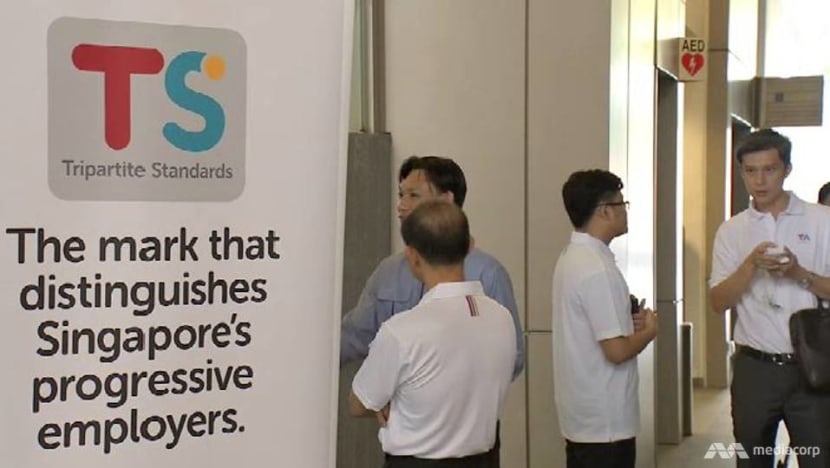commentary Commentary
Commentary: Grey areas surrounding wrongful dismissal guidelines
The tripartite guidelines are a noble effort but no guideline can fix unconscious bias, indirect discrimination and bullying, say management experts Carys Chan and Dawn Chow.

A man tired from working in the office. (Photo: Pixabay)
SINGAPORE: Do you know someone who felt unfairly treated and was let go of, yet couldn’t do anything about it because the situation did not fit wrongful dismissal guidelines?
Have you yourself felt unreasonably treated at work?
Chances are, most of us have had such experiences, or know of someone who has.
CAN WRONGFUL DISMISSAL BE FIXED WITH GUIDELINES?
Last Monday (Apr 1), the tripartite comprising the Ministry of Manpower (MOM), National Trades Union Congress (NTUC), and the Singapore National Employers Federation (SNEF) released a new set of guidelines on what constitutes wrongful dismissal under the Employment Act.
These new guidelines provide useful scenarios of what wrongful dismissal looks like – whether reasons relating to discrimination, the avoidance of the payments of benefits, and the punishing of an employee for exercising an employment right, such as the right to a break every six hours, among others.
Indeed, the promulgation of these guidelines signal a recognition of the importance of free and fair employment, and how critical ascertaining the real reason for an employee’s dismissal is to workers.
For instance, the guidelines make it clear it is wrong to dismiss an employee with notice if the employer projected a discriminatory attitude towards the employee (e.g., he or she made discriminatory remarks about the employee’s race).
READ: When demeaning job interviews and bad bosses are still the norm, a commentary
READ: Are you a bullying manager? It's easy to tell, a commentary
Another example of wrongful dismissal provided in the guidelines is the dismissal of an employee of three years who informed the company of her pregnancy, without the payment of maternity benefits or legitimate grounds for dismissal.
While the new tripartite guidelines and examples are a noble effort to provide clearer guidance and transparency on wrongful dismissal, the fact is that wrongful dismissal can take more subtle but insidious forms.

WRONGFUL DISMISSAL AND POOR MANAGEMENT
Dismissal often hinges upon what managers claim are legitimate grounds for dismissal. Yet, an employer might hold biases against an employee for his or her gender, race or religion, but terminate the employee’s contract based on “poor performance”.
For example, a fast-food worker in New York City was recently fired because she “was not smiling enough”.
While cheerfully greeting a customer might be a service standard fast food outlets can reasonably demand from employees, investigations later revealed that the manager already had plans to bring in employees from his previous workplace and just needed an excuse to lay off existing staff.
A track record of the employee’s past poor performance ought to be established – including documented performance reviews between the employee and his or her supervisor, as well as formal communication records that show fair warning was provided to the employee.
READ: The untold trade-off as a freelancer, when work is not work but 'opportunity', a commentary
When cases of wrongful dismissal are brought up, cross-checks with the employee’s co-workers and subordinates can provide a fuller picture of the circumstances leading up to the dismissal from many third parties’ perspectives.
Early warning to arrest the situation ought to be something companies consider. Having in place formal, informal, and anonymous feedback or reporting mechanisms can also help to ensure that employees who feel mistreated have an outlet for help and sharing their negative experiences.
For example, appointing a company ombudsman, who can act as an independent and neutral overseer, can help identify and informally resolve individual, group, and organisation-level concerns. Importantly, the ombudsman is not supposed to take action without the permission of the people or groups with whom they consult.

But all these measures alone cannot fix the root cause of many dismissal grievances, even if termination was made on sound grounds – which is that supervisors might not be equipped to deal with an under-performing employee, a situation that requires leadership, conflict resolution skills and empathy to give honest, critical and timely feedback.
UNCONSCIOUS BIAS AND INDIRECT DISCRIMINATION
So far we have assumed that employers are rational but can guidelines tackle unconscious bias and indirect discrimination?
Unconscious bias is far more prevalent than explicit forms of prejudice, but difficult to identify and tackle.
In many cases, people do not even realise that they were making unfair assumptions or stereotypes. While the guidelines tackle unfair dismissal, they do not address missed job opportunities which arise because of such biases.
Unconscious bias is the reason why managers tend to promote people who are similar to them, according to research conducted by a group of social psychologists at the University of New South Wales.
Unconscious bias has led to better-looking people standing a higher chance of being hired than other individuals of the same ability, another study carried out by psychology professor Comila Shahani-Denning in Hofstra University also revealed.
It is practically impossible to eradicate unconscious bias, which may take the form of indirect discrimination and manifest as unfair treatment.
Indirect discrimination is more subtle and insidious, and often does not have clear tell-tale signs.

An example of indirect discrimination would be a manager who expects a female employee to constantly put in overtime hours, but then proceeds to dismiss her after she returns from maternity leave and can no longer continue working overtime
The higher baseline the manager had set before the employee went for maternity leave created unfair expectations yet this scenario does not qualify as wrongful dismissal.
Should the employee be dismissed based on poor performance or organisational restructuring, additional investigation would be required to uncover the real reason why the employee was not able to meet his or her office role demands. Sometimes reorganisation is employed to force employees out of their roles.
READ: The myth of the superhero career woman is holding us back, a commentary
HARASSMENT, BULLYING AND WHISTLEBLOWING
What about mean bosses? If the spirit of the guidelines was to enact stronger protections for workers, why did the tripartite guidelines not include harassment, bullying and whistleblowing?
Many advanced countries around the world protect workers from vindictive, predatory managerial practices in the workplace.
Under Australia’s 2009 Fair Work Act, repeated threats of dismissal are a form of workplace harassment and bullying. Sometimes, bullying may also involve the termination of employment without a reason, and construes wrongful dismissal.
There is a worry that including these into formal guidelines might lead to a floodgate of workers externalising their differences with their employees instead of privately resolving these themselves, a scenario research finds unfounded.

The 2016 - 2017 Australian Fair Work Commission’s annual report revealed that of the 14,587 claims made for wrongful dismissal against Australian businesses in that year, 93 per cent of these cases were resolved before ever getting in front of a Commissioner, either because they had been “resolved informally” based on agreement by the parties involved, or because the applicant had dropped the claim.
The reality is that there is an asymmetry of power between a worker and his or her employer, and anything short of swift, decisive protection skews this balance against the worker further.
For instance, when it comes to workplace sexual harassment, victims were more likely to drop the claim against wrongful dismissal because the process to examine and remove the perpetrator was often slow, studies have shown. Many feel mentally and physically depleted to the point of exhaustion, and delay or choose not to report the perpetrator.
Similarly, whistleblowers in various organisations across the world continue to face unfair dismissal due to the lack of uniform protection laws, hence most whistleblowers still prefer to report corporate irregularities anonymously due to fears of reprisal.
READ: A culture of overtime is costing us dearly, a commentary
The tripartite guidelines should therefore include provisions to ensure that victims of workplace harassment and bullying, and whistleblowers, are better protected, as these groups of employees are most likely to slip through the cracks.
Specific, separate clauses on harassment, bullying and whistleblowing might be in order, as they are each a potential cause of wrongful dismissal difficult to detect.
Separately, the onus should be on employers to take proactive steps to prevent workplace harassment and bullying before they happen. Some of these guidelines could be spelled out in organisational policies, or else mandated into law into the Employment Act.

WHAT’S NEEDED TO AVOID WRONGFUL DISMISSAL?
Tackling wrongful dismissal is as much a company’s responsibility as the tripartite partners, for it has huge repercussions on corporate reputation.
Companies should have in place an up-to-date workplace policy in line with the tripartite guidelines, and communicate with their employees the latest developments in this space. For example, employers can organise workshops to discuss the different scenarios of wrongful dismissal illustrated in the new tripartite guidelines.
While the guidelines may be a work-in-progress and can be refined via ongoing discussions with industry experts, researchers, as well as other stakeholders, forward-looking organisations will invest time and effort to communicate to employees these latest developments in wrongful dismissal legislation for two reasons.
First, it is an opportunity to outline expectations regarding work performance standards and professional behaviour, since employment may be terminated on the grounds of misconduct and poor performance.
Second, it signals to employees that their work rights are being cared for, which in turn fosters trust and respect.
Instead of a formal annual performance review, companies should also encourage a two-way conversation between supervisors and their subordinates. Building a constructive climate in the workplace can have knock-on benefits.
Research has shown that increased self-awareness is associated with better performance outcomes, so leaders should make use of 360 degree feedback processes to understand how their team members see them.
Finally, employers and supervisors should reflect and act on their employees’ feedback, otherwise the cycle of wrongful dismissal will be self-fulfilling.
Carys Chan is Lecturer and Assistant Professor in Management at RMIT University. Dawn Chow is Lecturer in Business at the Singapore University of Social Sciences.
















